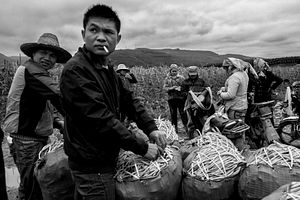Luc Forsyth and Gareth Bright have set out on a journey to follow the Mekong river from sea to source. The Diplomat will be sharing some of the stories they’ve found along the way. For more about the project, check out the whole series here.
A thick mist settled over the highway as we drove out of Jinghong, and only through short patches in the haze could we see the extent of the vast scenery we were passing. We were headed to the southeastern edge of Xishuangbanna prefecture, just 30 km from the Burmese border, to visit several communities of Dai people.
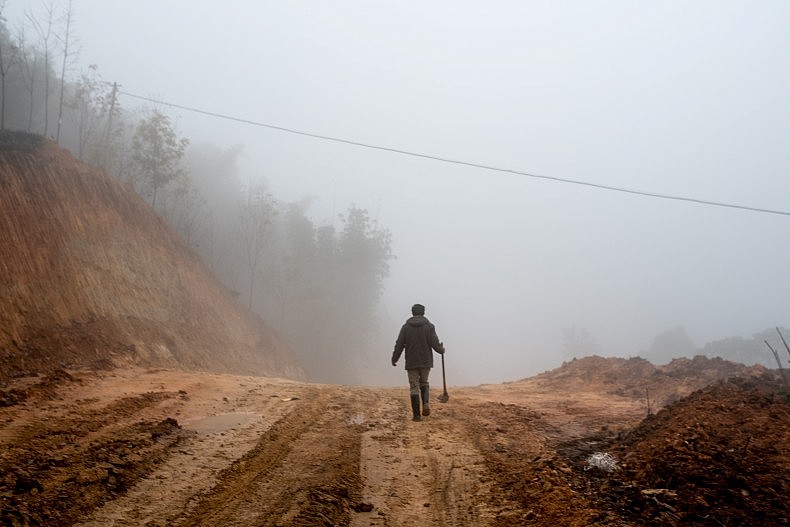
A road repair worker in Basa village, Xishuangbanna, China. The village is home to the Jinuo ethnic minority. Photo by Luc Forsyth.
An ethnic minority, the Dai people were part of an ancient culture that inhabited what is now China’s Yunnan province until political chaos and wars forced them to disperse south. Now spread across China, Laos, Vietnam, Myanmar, and Thailand, the roughly 60 million Dai are divided by modern international borders.
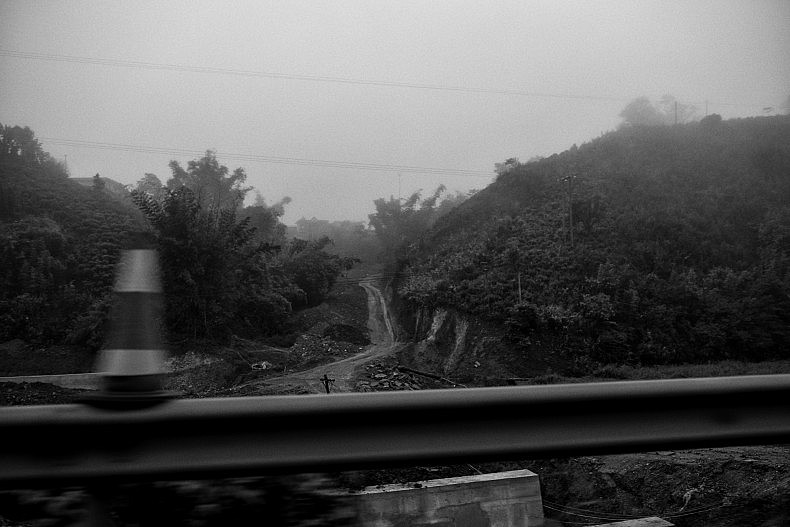
Scene from a car on the way to Dai villages in Xishuangbanna, China. Photo by Gareth Bright.
As we wound our way along the mountain road that would take us to the Dai villages, we passed through dozens of other small villages, catching fleeting glimpses of people walking through the blanketing fog, heading to their farms or leading their livestock to feed. It wasn’t until we arrived at Olive Dam — so named for its resemblance to an olive from the air, and the word dam meaning “basin” in Mandarin — situated at the bottom of a deep valley, that the sun fully rose to burn off the mist.
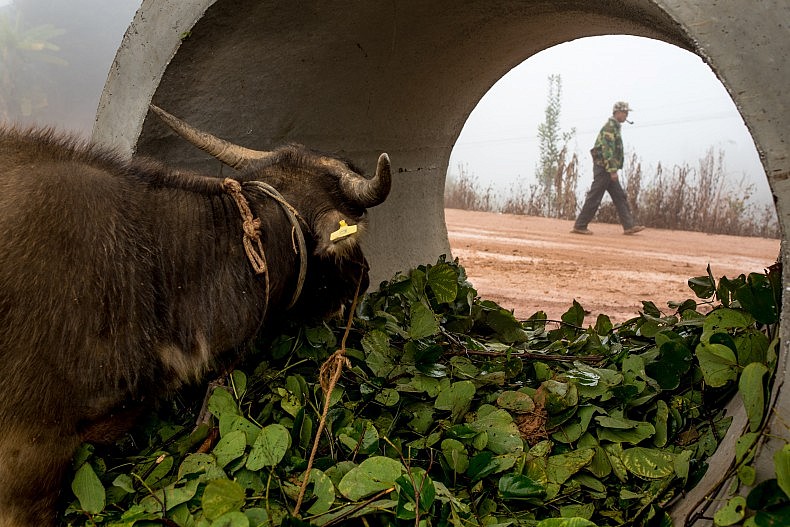
A water buffalo watches a Jinuo farmer in Basa village, Xishuangbanna, China. The Jinuo are an ethnic minority found in Western China. Photo by Luc Forsyth.
Packaged Culture
Though we knew the area was advertised heavily as a tourist attraction, the extent of the commercialization of the culture seemed excessive. Gift shops and souvenir stalls lined a large parking lot where tour buses had already gathered, despite the early hour. An information pamphlet welcomed us to the “Dai Minority Park,” and we began to suspect that the day’s cultural experience might be something less than authentic.
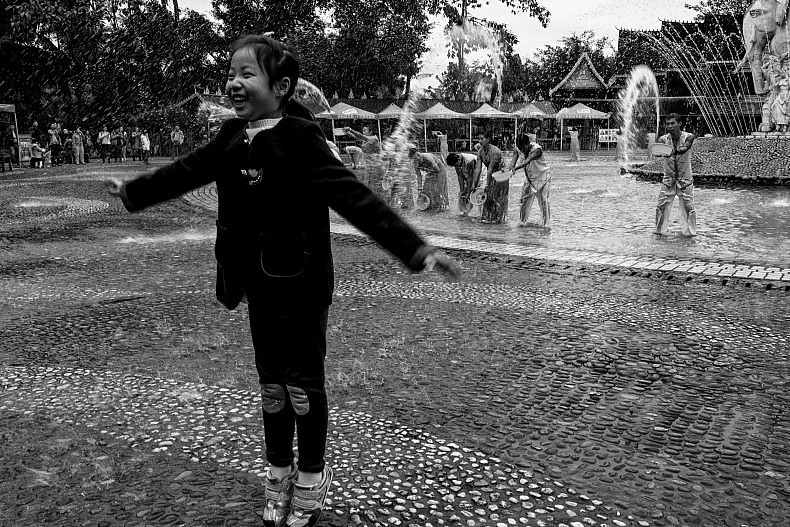
Residents and staff at the Olive Dam Dai cultural village take part in a daily water festival, Xishuangbanna, China. Photo by Gareth Bright.
Through our Mandarin speaking friend and travel companion, Yan, we learned that in fact the park was owned by a private real estate developer that had consolidated several Dai villages into a single tourist destination. In exchange, a portion of the income was given back to the Dais in the form of jobs, infrastructure, and possibly cash. While we decided to reserve judgement until we had seen more of what lay inside, we immediately began referring to the area as “the theme park,” and the immaculately paved roads and manicured gardens further bolstered our skepticism.
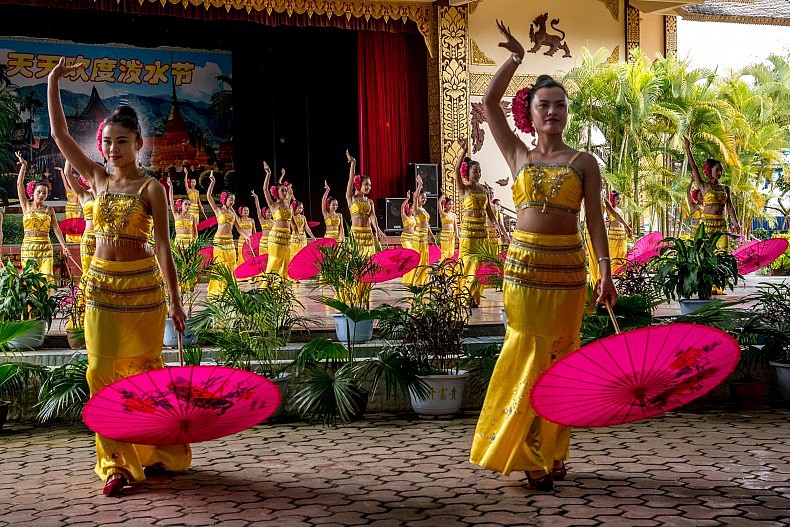
Dancers perform for tourists at the Olive Dam Dai cultural village in Xishuangbanna, China. Photo by Luc Forsyth.
As we walked through the community, it was clear that the residents of the minority park were far better off financially than those in the less developed villages we had passed earlier that morning. Most of the houses were new looking and well built with concrete and finished wood, and newish looking cars and motorcycles were parked in front of the majority. Living in the theme park was apparently not without benefits.
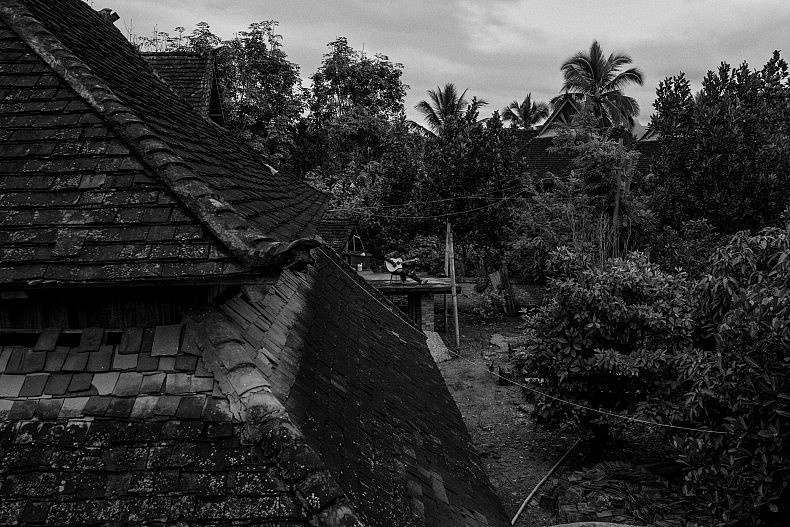
A man plays guitar on the roof of a house in Olive Dam Dai cultural village in Xishuangbanna, China. Photo by Gareth Bright.
In the distance the thumping bass of loud music drew us deeper into the village until we reached a large open area, packed with people. In the center Dais, dressed in brightly colored silks, splashed in a shallow pool of water encircling a fountain as tourists ringed the outer edges, cameras at the ready. The event was a reenactment of the annual water festival celebrated in April of each year, held here twice a day for the enjoyment of visitors. And while the whole affair was a rehearsed performance, the Dai actors were clearly enjoying themselves as they hurled buckets of water at each other, and occasionally those tourists who ventured too near the water’s edge.
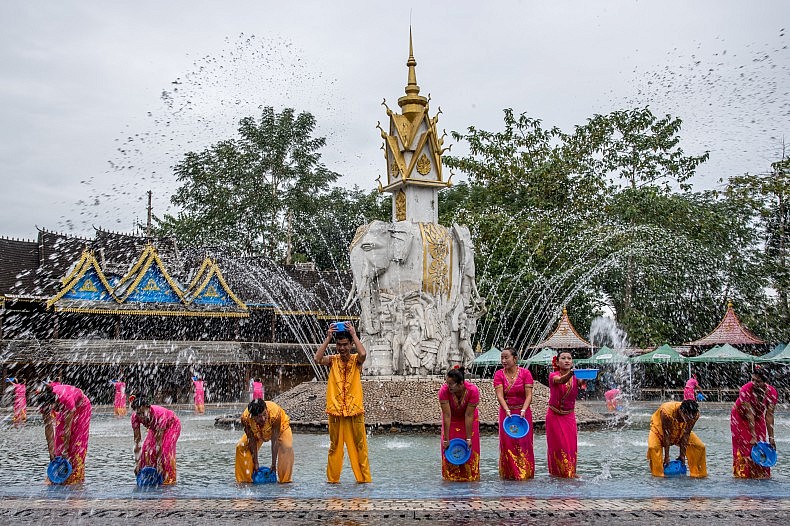
The performance of an April water ritual is is put on twice a day at the Olive Dam Dai cultural village. Photo by Luc Forsyth.
After half an hour of the playful display, the crowd migrated toward a nearby stadium, stopping to buy snacks of fried vegetables or spicy papaya salad. A solitary caged elephant stood by, and some visitors opted to climb a metal staircase onto its back to have their photos taken. Since spending a great deal of time earlier in the journey learning about the precarious relationship between humans and elephants in Laos, we were especially sensitive to the plight of the animals and the sight somewhat dampened our spirits. However we knew there was nothing to be done about it, save staging an ill-advised prison break, so we resigned ourselves to muttering an impotent apology to the animal as we joined the flow of people entering the stadium.
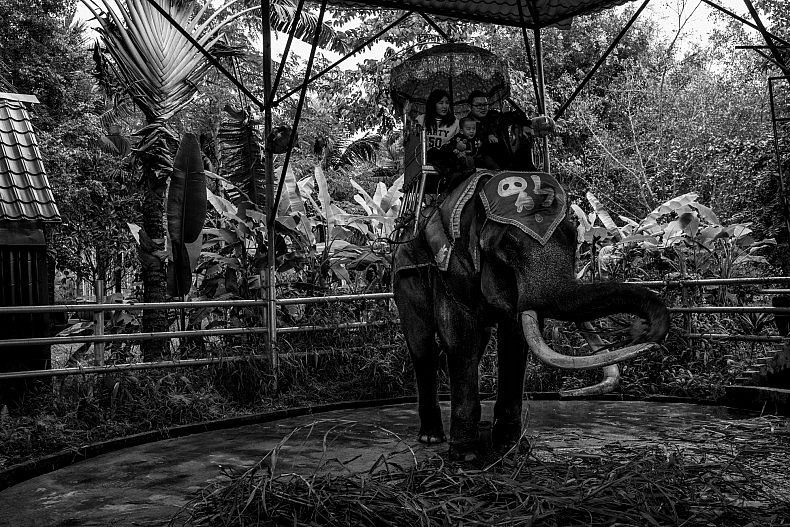
An elephant, with tourists atop, at the Olive Dam Dai cultural village in Xishuangbanna, China. Photo by Gareth Bright.
For the next hour the audience was treated to a variety of Dai traditional dances and calligraphy displays. While the dances were impressively choreographed, with dozens of young women in beautiful silken dresses, and the calligrapher mesmerizing to watch as he smoothly painted characters onto large parchments, we knew we were learning about as much about the realities of modern day Dai life as a trip to Disneyland could teach us about film production.
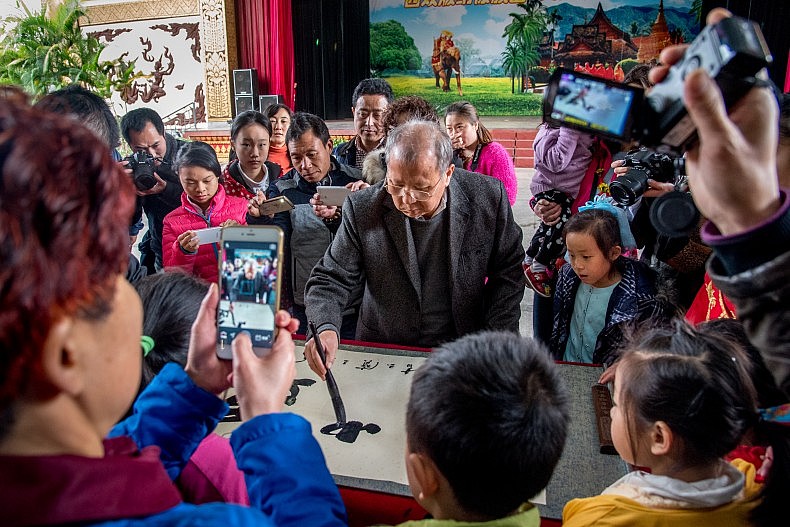
A Chinese calligraphy demonstration for tourists at the Olive Dam Dai cultural village. Photo by Luc Forsyth.
There was nothing inherently wrong with the Dai Minority Village, and obviously it had brought security and prosperity to the communities. Dancing was surely a nicer way to make a living than toiling in the fields, but we wanted to get away from the canned performances to see what normal Dai people did in their everyday lives.
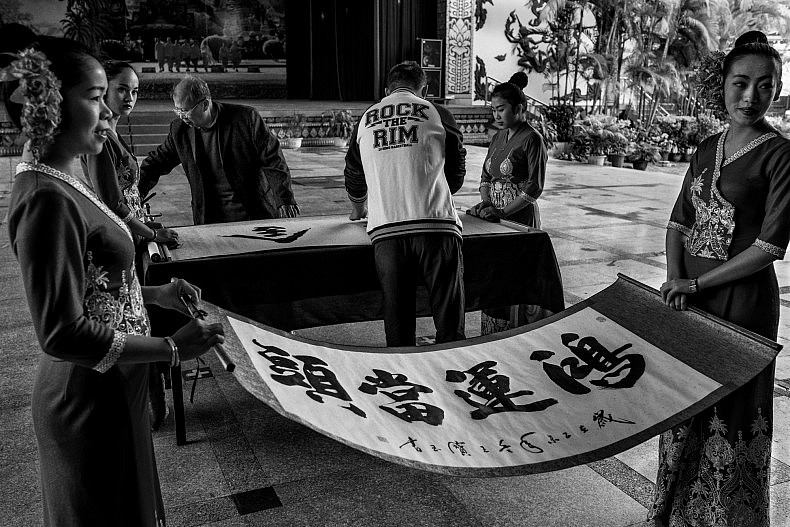
Women at the Olive Dam Dai cultural village hold examples of Chinese calligraphy. Photo by Gareth Bright.
The Opposite Bank
After waiting for the arrival of a small ferry boat to shuttle us across the Lancang to the Dai village of Manhenuan, the difference was immediately obvious. Unlike in the Minority Park with its expansive paved roads, there was only a stone beach with a rutted motorcycle path that led inland. Locals sat along the water’s edge, casting fishing rods into the river and waiting patiently for bites that did not seem to come.
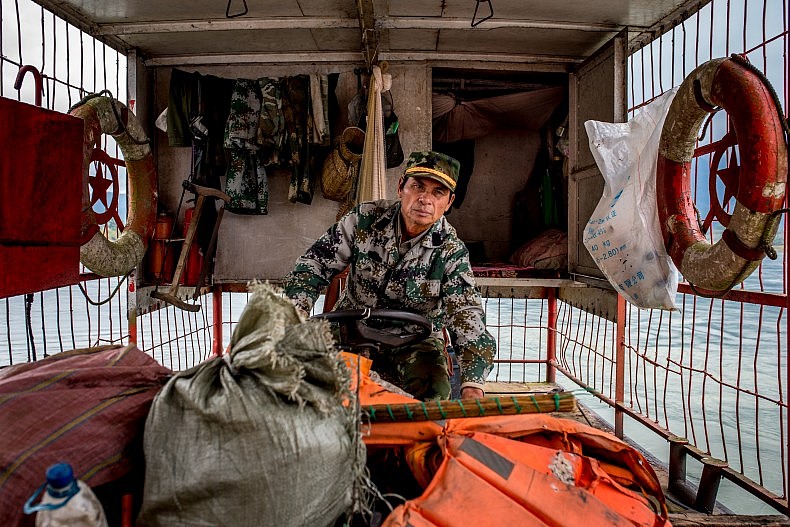
A ferry boat captain shuttles passengers between Olive Dam and Manhenuan villages, in Xishuangbanna prefecture, China. Photo by Luc Forsyth.
“Here we grow many things like bananas, corn, rubber, and beans,” Yu Yinghan said. A young woman in her late 20s, we had found Yu fishing with her husband on the river’s edge and stopped to ask her about the differences between Manhenuan and the nearby cultural park. “We have what we need here, so we don’t want to work full time for a big company. We would rather work for ourselves.”
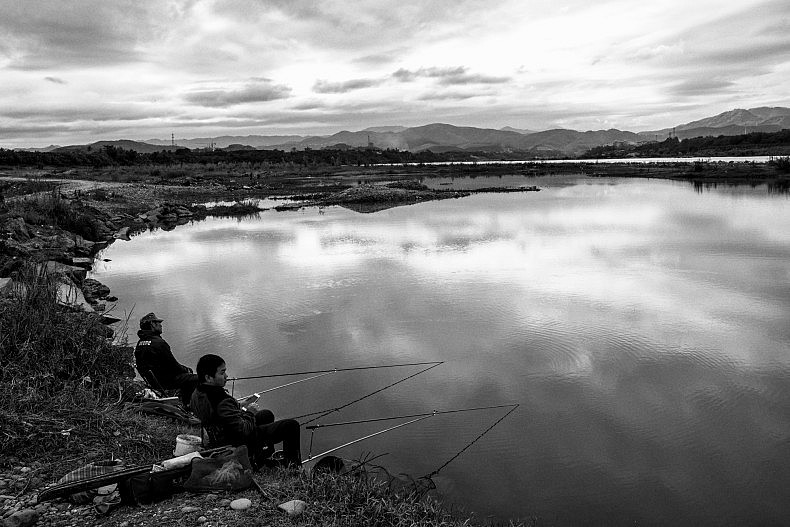
Residents fish in the Lancang (Mekong) river near Manhenuan village. Photo by Gareth Bright.
Further inland, the rockiness of the Lancang’s banks gave way to bright green expanses of farmland, set against the backdrop of the rolling mountains on the horizon. Moving between neat rows of string beans, we met Yan Wenxiang and decided to switch gears to ask about the role of the Lancang in the daily lives of Manhenuan residents.
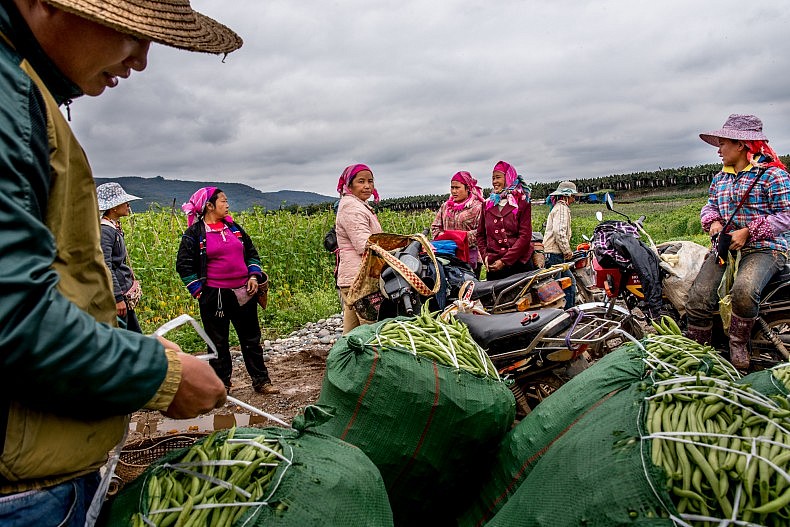
Farmers pack freshly picked beans and peas into sacks for transport to local markets in Manhenuan village. Photo by Luc Forsyth.
“I’ve lived here my whole life,” he said. “I water my crops from the river, though it’s too dirty to drink. Usually there is enough [for the crops], but sometimes because of the nearby dams there is not. Yesterday there was enough, but not today.”
Unlike those across the river, the Dais of Manhenuan lived a more traditional lifestyle and relied on the land and its natural resources as their primary source of income, instead of the tourist dollars that supported the Minority Park.
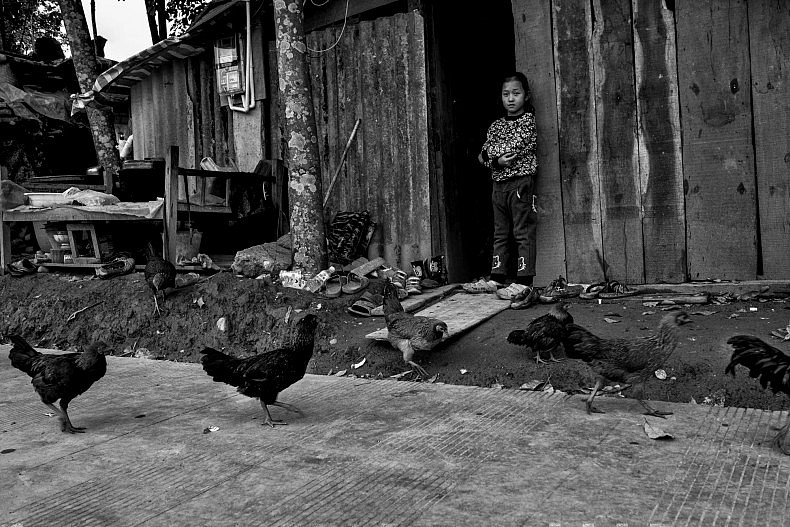
A young girl stands outside her family home in Manhenuan village. Photo by Gareth Bright.
While we watched laborers heft 60 kg sacks of picked beans onto tractors to be sold for 2-3 RMB (roughly $0.50) per kilogram, we chatted with them and reflected on the strange paradox of development. As outside observers, the rural lifestyle of Manhenuan’s farming Dais conjured words like “idyllic” and “natural” in our minds. Friendly and laughing the whole time they worked, it would have been easy to assume that this way of living was inherently better than allowing a real estate company to turn their village into a theme park.
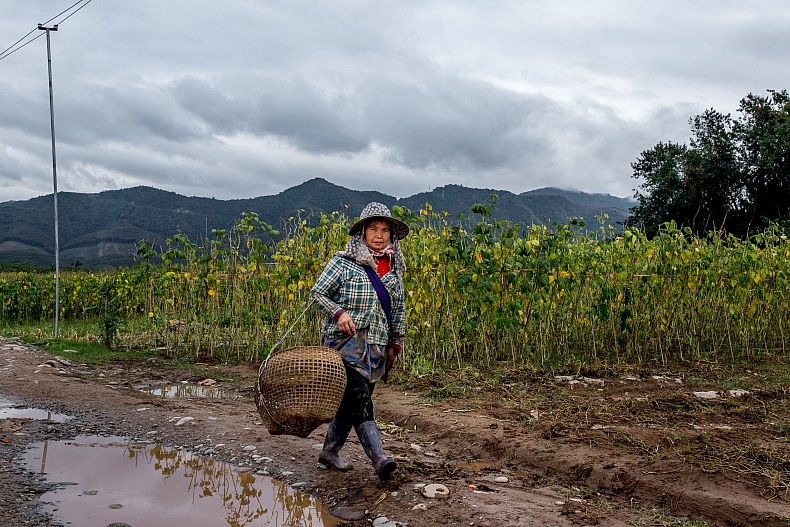
A woman walks past the farmland of Manhenuan village. Photo by Luc Forsyth.
But at the same time, as we watched the workers sweat under the weight of the beans, it was obvious that this was not easy work — either physically or financially. As always, we had to remind ourselves not to judge the quality of the lives of others based on romanticized notions of simpler times.
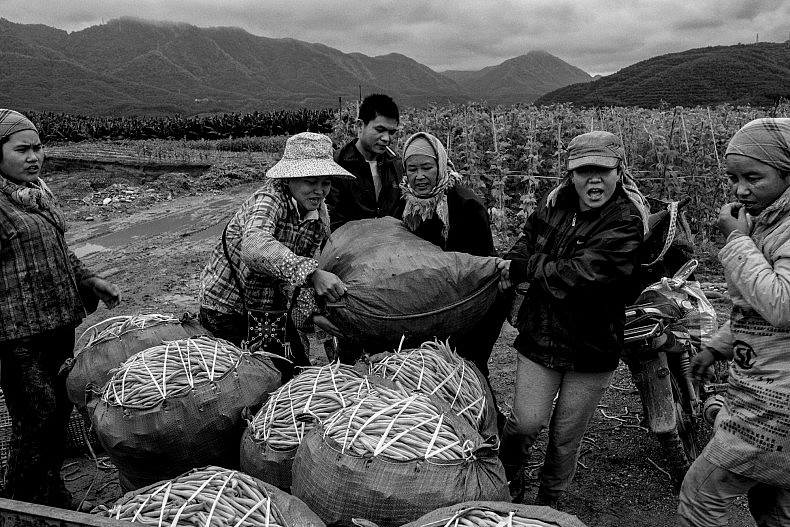
Farmers pack freshly picked beans and peas into sacks for transport to local markets in Manhenuan village. Photo by Gareth Bright.
Following a dirt road for a few kilometers, we reached the center of Manhenuan town and immediately realized that the community was already on its way to following in the footsteps of the Minority Park. Multiple construction crews and 70-tonne excavators were busily tearing up the small roads and preparing them for paving. Building sites were everywhere, and the extent of the bamboo scaffolding indicated that the new structures would almost certainly dwarf the existing ones.
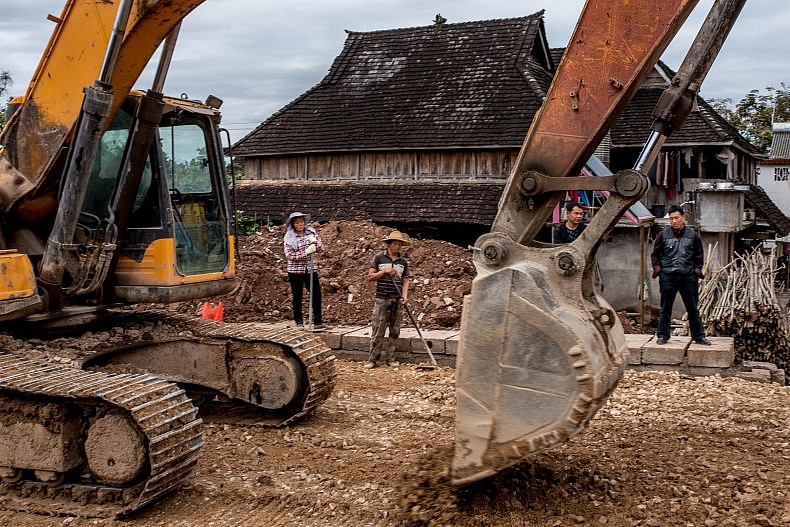
With the financial success of the nearby Dai minority cultural village at Olive Dam, residents of Manhenuan are trying to open their village up to tourism. as well. Photo by Luc Forsyth.
“Soon a new bridge will be built and it will allow tourists to come here more easily,” Yan Ying said. Fifty-two years old and sporting a magnificent Soviet-style winter hat, Yan explained that Manhenuan was preparing to follow the example of the Dai across the Lancang and convert itself into a tourist attraction. “Many things are changing.”
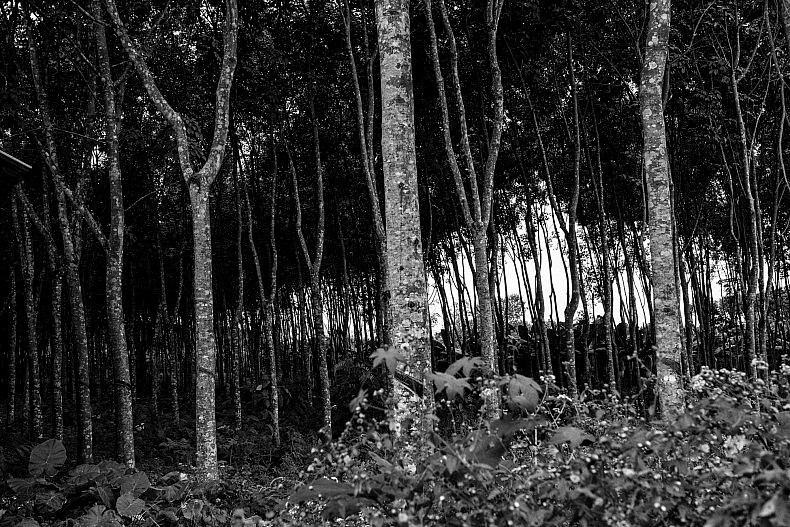
Rubber tree plantation in Manhenuan village, Xishuangbanna, China. Photo by Gareth Bright.
Currently living in a small makeshift shack with his wife and daughters, Yan had torn down his house in order to build a more modern structure in its place. “I thought about building a traditional style house, but I decided to use bricks so I could rent out the rooms to tourists,” he said.
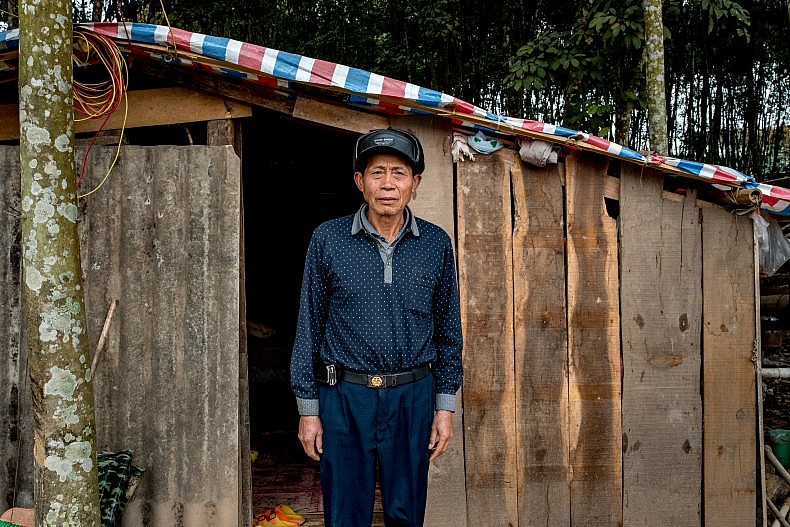
Yan Ying, 52, stands in front of his home in Manhenuan. Photo by Luc Forsyth.
When we asked him several loaded questions, trying to gauge if he felt any anger about the imminent commercialization of his village, he didn’t express any personal misgivings. “I don’t own any land, and since there is none available to buy, tourists will be the best way for me to earn money to give to my children.”
“Some people are arguing with the company,” he admitted after continued probing. “They think we aren’t being paid enough. But for me it’s good.”
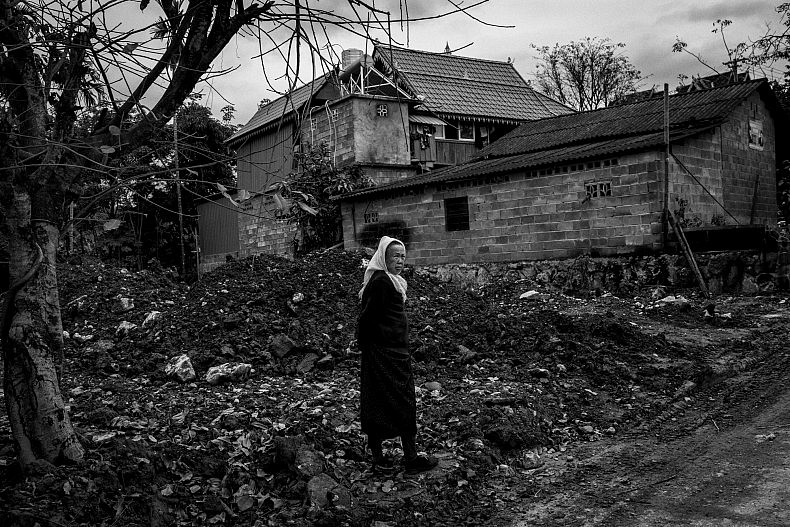
A woman stands in a demolished plot of land in Manhenuan village. Photo by Gareth Bright.
As we left Manhenuan, we couldn’t help but feel saddened by the knowledge that the little village would probably be unrecognizable if we returned in five years. But at the same time, it was more than understandable that Yan preferred the thought of his daughters working in an air-conditioned hotel instead of laboring in a sweltering bean field.
For better or for worse, the modern world would march on. We could only hope that in the process Dai traditions would not become just another packaged culture for the convenient consumption of those who could afford the price of admission.
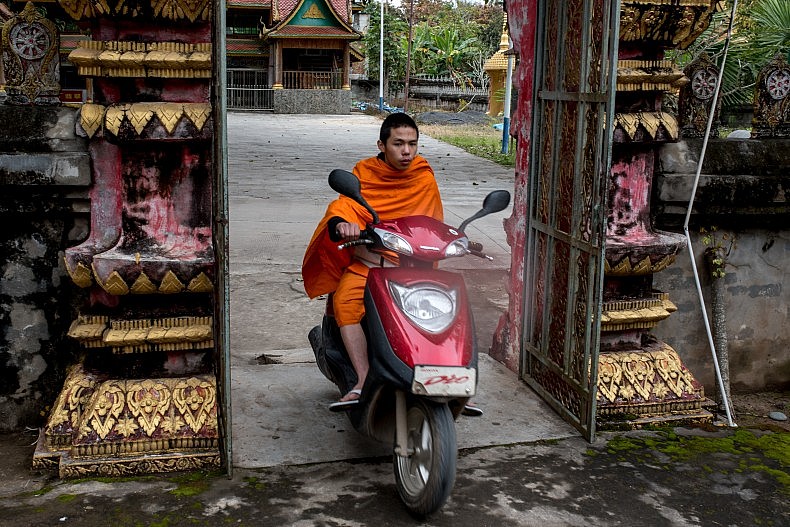
A monk drives a scooter in the Olive Dam Dai cultural village in Xishuangbanna, China. Photo by Luc Forsyth.
This piece originally appeared at A River’s Tail.













